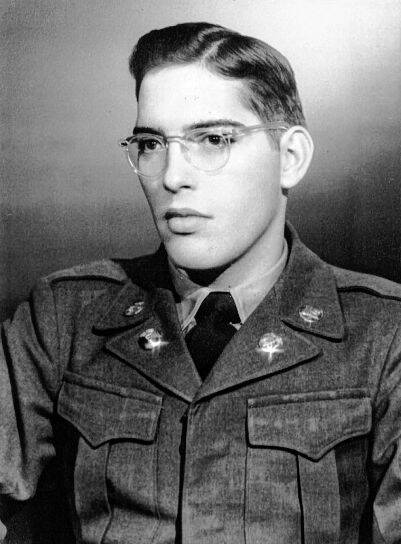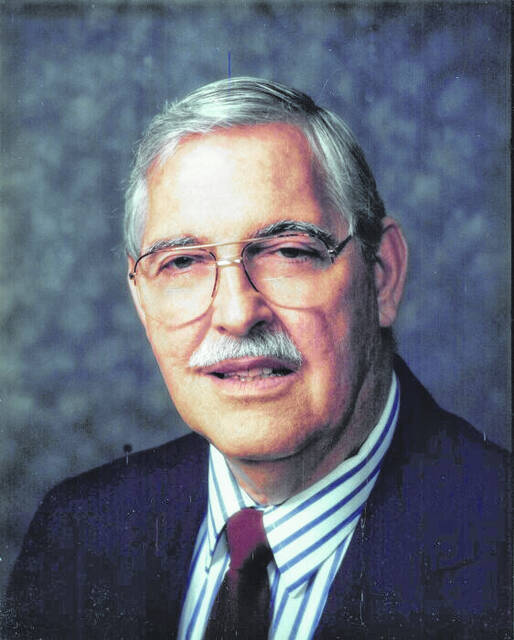

Hiser in uniform, 1948.
Provided photo

Hiser later in life.
Provided photo
By Vivian Blevins
Contributing Columnist
Our Korean War veterans are departing this earth at a rapid rate, and soon their accounts of their war will be relegated to historians-unless we capture the experiences of those who were there. Some of us know about the Battle of Heartbreak Ridge, or the Battler of Inchon, or the one at the Chosin Reservoir. Almost all of us, however, know about the MASH units of the Korean War.
Even today we can watch the television series “M*A*S*H” which depicts a fictional unit, 4077th Mobile Army Surgical Hospital, or read the book by Dr. Richard Hornberger, pen name Richard Hooker, who served in a MASH unit in Korea.
In an interview with me in 2016, retired Piqua attorney Ben Hiser (May 26, 1930 to September 23, 2021) validated the realism of the television series because he was there.
Unemployable because he was a reservist after a stint in the U.S. Army (1948 to 1950), and employers were reluctant to hire and train him only to have him be called up for another war, Hiser was advised to get a discharge and re-enlist. He did and was off to Fort Knox, Ky., for an assignment on a garbage truck with a 12-gauge, sawed-off shotgun monitoring GIs who had been court-martialed and were assigned garbage detail on the base.
Next were orders to go to the Far East via Fort Lewis, Wash., where he was issued an M-1 carbine, given a tag, and told to write his name and address on it and put all his belonging, except his field uniform, in a duffel bag for shipping back to Piqua.
His next stop was McCord Air Force Base in Tacoma, Wash., where he boarded a Canadian Air Force C-54 headed north over the Canadian Islands. That hop was short as a flight engineer left his seat and told those aboard, “Keep your eye out for oil. I think one of the engines is losing oil.” It was, so that engine was shut off, and the pilot landed the aircraft at Elmendorf Air Force Base to have the engine replaced.
The next stop was Shemya, Japan, for refueling and to take on provisions before finally arriving at Camp Drake in Tokyo.
There Hiser was a part of a medical unit dispensary adjacent to a fire station manned by Japanese. Hiser says, “The barracks at the camp were two-story, made of wood, and a fire hazard.” As an ambulance driver, one of Hiser’s jobs was to follow fire trucks over narrow roads and then get the seriously injured to Yokohama to 361st Station Hospital or to Tokyo Army Hospital.
Hiser said, “We gave first aid that was primitive by any standard. We tried to stop bleeding, splint fractures, transport the patients without doing any further damage, and get them to the closest medical facility.
“Life can be really boring when you’re waiting to be needed, and there was an excellent and popular rifle range at Drake that had been built by American POWs. We’d go out there and wait for someone to shoot himself or someone else. It was going to happen, and it was just a matter of when.
“When college boys were rotated in at the dispensary, the lieutenant colonel in charge was promoting them over us, and I got pretty irritated and told him, ‘I want to go to Korea.’”
So Hiser went to Wonju, Korea, to the Eleventh Evacuation Hospital where his new title was surgical technician.
Hiser laughed, “What do I do as a surgical technician? How had I been trained? According to the Army, ‘Hit don’t make no never mind.’ I carried patients in and out, cleaned up after them, cleaned syringes which we reused, and was a member of the penicillin team to go to the ward and administer this scarce commodity to the patients.
“Then I learned that my brother, Harold Louis, also a medic, had been drafted and was sent to Korea as a member of the 40th Infantry Division at Sniper’s Ridge.”
The next stop for Hiser was the 40th. He said, “It was like a scene out of ‘Apocalypse Now.’ I tried to tell the personnel officer that I didn’t want to be a medic, but I might as well have been talking to the coal oil lamp hanging over our heads. He assigned me as a medic to Nine 81st Field Artillery Regiment Aid Station, a tent the size of a two-car garage. I arrived, saluted the commanding officer, and said, ‘Corporal Hiser reporting for duty, sir.’ He never looked up and said, ‘Do you play bridge?’”
Hiser responded, “No, sir” and was sent to Battery A where Americans were shooting 155-millimeter guns at thousands of Chinese and North Koreans. Hiser said, “Remember the helicopters delivering the wounded to the M*A*S*H doctors? That’s the way it was, doing our best to get the seriously wounded to a doctor to stabilize them, and then trying to get the guys living in holes in the ground to not defecate in those holes and cause sanitation problems. I did very well in treating some cases, and some I wish I had done a lot better.”
At sick call, Hiser had elixir of Terpene Hygrade Codeine, APCs (a pill of aspirin, pheniticin, and caffeine), paregoric for GI issues, and DDT for body lice.
Hiser said, “One day my commanding officer approached me and said that I had 36 points and could rotate home.”
Of “M*A*S*H,” Hiser said, That son of a gun, Dr. Hornberger, was there. He knew.”
Hiser exited the war. At the dock in Oakland, Calif., he was greeted by a 15-piece band and a girl singing “My Hero” from “The Chocolate Soldier.”
PS: At age 50, Hiser earned his law degree from the University of Dayton. His life was not easy, but he persevered and made a tremendous positive difference in the lives of so many, including mine and those of my students at Edison State Community College.
Vivian B. Blevins. Ph.D., a graduate of The Ohio State University, served as a community college president for 15 years in Kentucky, Texas, California, and Missouri before returning to Ohio to teach telecommunication employees from around the country and students at Edison State Community College and to work with veterans. Viewpoints expressed in the article are the work of the author. The Daily Advocate does not endorse these viewpoints or the independent activities of the author.




